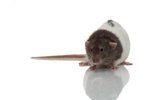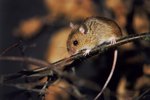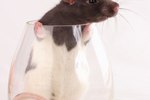
Rats are equipped with a few powerful senses that help them navigate the environment, find food and recognize one another -- but vision is not one of them. While their sense of vision is well-adapted for avoiding predators, it is one of their overall weakest senses, and not particularly useful when exploring and searching for food.
Sense of Vision
Rats are colorblind, and their eyesight is generally poor. This is one reason that rats are typically nocturnal -- they don't rely on their ability to see to get around. Their small, black and beady eyes disguise one particularly useful adaptation, though: the ability to see in two directions at once. Unlike humans, rats can look in two separate directions at the same time. This means that while one eye scans the environment at ground level, the other can be fixated upward, helping the rat avoid flying predators like hawks and owls.
Feeling Around
When you try to navigate a darkened room, you may walk with your arms outstretched so you can feel around for walls -- this is similar to how rats navigate. In addition to whiskers like a cat's, which help them maintain their equilibrium, rats have body hairs that are particularly sensitive. They use these hairs and whiskers to feel around the environment. This is why rats typically run along walls, rather than across an open floor -- it allows them to have a better sense of where they are.
Scent Receptors
Another way that rats make up for their poor eyesight is with an excellent sense of smell, which is critical not only to discovering food, but also to navigation and identifying one another. A rat's sense of smell is sensitive enough to identify others by their scents, allowing them to recognize each other despite a lack of distinguishing physical features. Rats also use their own urine like a trail of bread crumbs, marking periodically along a path so that if need be, they can follow their own scent to leave the way they came.
Powerful Taste Buds
Rats rely heavily on their powerful sense of taste, which helps compensate for their lack of visual acuity. They explore food options not by sight, but by sampling and using their sense of taste to determine whether the food is safe. Rats are able to detect poison and other contaminants in their food in quantities between 0.5 and 2 parts per million, allowing them to avoid eating anything that could be fatal. Despite their keen sense of taste, rats are not particularly picky eaters. They are opportunistic and adventurous, which makes their ability to detect compromised food all the more critical to survival.
References
Photo Credits
-
NA/AbleStock.com/Getty Images
Writer Bio
Tom Ryan is a freelance writer, editor and English tutor. He graduated from the University of Pittsburgh with a degree in English writing, and has also worked as an arts and entertainment reporter with "The Pitt News" and a public relations and advertising copywriter with the Carnegie Library of Pittsburgh.




